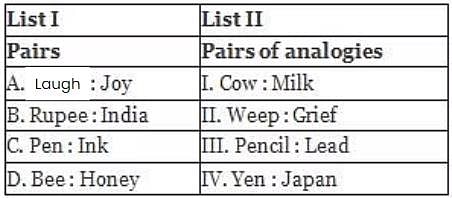TS SET Paper 1 Mock Test - 3 - TS TET MCQ
30 Questions MCQ Test TS SET Mock Test Series 2024 - TS SET Paper 1 Mock Test - 3
Which of the following statements about UPSC is not true?
Which of the following learner characteristics are likely to influence the effectiveness of teaching aids and evaluation systems to ensure positive results?
(A) Learner’s family background, age and habitation
(B) Learner’s parentage, socio-economic background and performance in learning of the concerned subject
(C) Learner’s stage of development, social background and personal interests
(D) Learner’s maturity level, academic performance level and motivational dispositions
Which of the following statements is incorrect regarding Kyoto protocol?
(A) UNO conducted this meeting.
(B) Limiting the emission of green house gases up to 5.2%.
(C) Protect mother earth.
(D) Find out the reasons for population explosion.
Match List I with List II
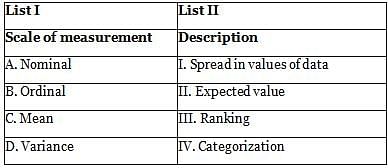
Choose the correct answer from the options given below.
Directions: Answer the given question based on the following table.
Marks obtained by 6 candidates A, B, C, D, E and F:
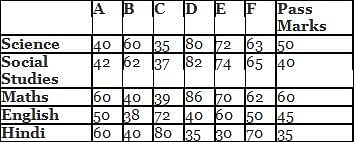
Q. The marks obtained by C in English were what percentage more than those obtained by F in Maths?
Match List - I with List - II and select the correct answer using the codes given below:

The difference between the ages of two men is 10 years. 15 years ago, the elder one was twice as old as the younger one. The present age of the elder man is
In respect of computer software, features of a typical operating system include:
A. The interface‐allowing communication between the user and the computer
B. Memory management‐allocating internal memory (RAM) to programs and data in use and retrieving and storing data on the external memory devices
C. Resource handling‐controlling peripheral devices (input and output devices) and handling user requests for peripheral devices
D. Internet access‐providing connectivity to the services on the Internet
Choose the correct answer from the options given below:
Which of the following is also known as a web address?
Match List – I with List – II and find the correct answer from the codes given below:

A teacher who is not proficient in the local language or dialect will face ________ barrier in communication.
Which of the following is not a type of Research Method?
Direction: Read the following passage carefully and answer the question.
If India has to develop her internal strengths, the nation has to focus on the technological imperatives, keeping in mind three dynamic dimensions: the people, the overall economy and the strategic interests. These technological imperatives also take into account a ‘fourth’ dimension, time, an offshoot of modern-day dynamism in business, trade, and technology that leads to continually shifting targets. We believe that technological strengths are especially crucial in dealing with this fourth dimension underlying continuous change in the aspirations of the people, the economy in the global context, and the strategic interests. The progress of technology lies at the heart of human history. Technological strengths are the key to creating more productive employment in an increasingly competitive market place and to continually upgrade human skills. Without a pervasive use of technologies, we cannot achieve the overall development of our people in the years to come. The direct linkages of technology to the nation’s strategic strengths are becoming more and more clear, especially since the 1990s. India’s own strength in a number of core areas still puts it in a position of reasonable strength in the geopolitical context. Any nation aspiring to become a developed one needs to have strengths in various strategic technologies and also the ability to continually upgrade them through its own creative strengths. For people-oriented actions as well, whether for the creation of large scale productive employment or for ensuring nutritional and health security for people or for better living conditions, technology is the only vital input. The absence of greater technological impetus could lead to lower productivity and wastage of precious natural resources. Activities with low productivity or low-value addition, in the final analysis, hurt the poorest most. The technological imperatives to lift our people to a new life, and to life, they are entitled to be important. India, aspiring to become a major economic power in terms of trade and increase in GDP, cannot succeed on the strength of turnkey projects designed and built abroad or only through large-scale imports of plant machinery, equipment and know-how. Even while being alive to the short-term realities, medium and long-term strategies to develop core technological strengths within our industry are vital for envisioning a developed India.
Q. According to the above passage, which of the following are indicative of the fourth dimension?
1) Aspirations of people
2) Modern day dynamism
3) Economy in the global context
4) Strategic interests
Code:
Given below are two statements:
Statement (I): Lecture-cum-Demonstration method can be used by the teachers for better results.
Statement (II): The project method is helpful in bringing out the creative and investigating aspect of the child.
In the light of the above statements, choose the most appropriate answer from the options given below:
Direction: The given table represents the number of employees recruited by four companies A, B, C and D in the five years. Study the table carefully and answer the following questions.
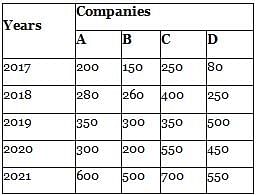
Q. Find the average number of employees recruited by company C and D together for all five years:
Direction: Read the given passage and answer the questions that follow.
Early feminist theory had emphasised the commonalities of women's oppression, neglecting profound differences between women in terms of class, age, religion, race and nation. As its exclusionary nature became evident, the collective 'we' of feminism was called into question. The inadequacies of feminist theorising that conflated the condition of white, middle class women with the condition of all women were highlighted in North America by black and Latin feminists, and in Britain by black and Asian feminists. Such critiques evoked the concepts of 'inter‐locking identities' and inter‐locking oppressions'. Related and more radical analyses came from feminist scholars in the Third world, where quite different agendas were called for. These critiques heightened the irrelevance of western feminism's analytical frameworks to the lives of most women around the world and attempted to reposition feminist debate within broader social, economic and cultural contexts of analysis advocated by scholars such as Janus. Such critiques spoke from a post‐colonial position, in which the self‐assumed authority of western feminists to speak about or indeed for others was disputed and decentered. Influential accounts of the tendencies of masculinist imperialist ideological formation to construct a 'monolithic Third world' woman', discursively constituted as the universal victim of Third world patriarchy, challenged feminists to "unlearn" their privilege and to deconstruct their own authority as intellectuals. These positions appeared to question the legitimacy of outside intervention of any kind, whether intellectual or political. Although subsequently attempted by the Third world scholars anxious to move beyond standpoints that threatened to mark all feminist politics as either inauthentic or unnecessary, they were enduringly influential in highlighting the questions identity and authority in feminist studies.
Q. The analytical frameworks of western feminists were critiqued by Third world scholars as:
Which of the following areas of liberal education at the higher level in the feudal society of Europe were classified under quadrivium?
A. Grammar
B. Logic
C. Arithmetic
D. Astronomy
E. Music
Choose the correct answer from the given options.
Directions: Study the given table and answer the following question.
The following table shows the number of students of 7 colleges participating in extra curricular activities:
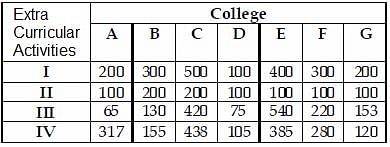
Q. Percentage of the number of students in activity II to that of IV is
Which one of the following references is written according to American Psychological Association (APA) format?
Directions: Read the below information carefully and answer the question that follow.
The bar graph shows revenue (in lakhs) of a food company that sells different kinds of food items:

Q. What is the growth in total revenue from 2004 to 2006?
Match List I with List II

Choose the correct answer from the options given below:
Direction: Given below are two statements, one is labelled as Assertion A and the other is labelled Reason R.
Assertion A: A teacher should try to collect as much information about the learners’ characteristics as he/she can.
Reason R: This helps in modifying instructions as per the needs of the students.
Following are the experimental learning activities adopted by a teacher. Arrange them in cyclic order.
(i) Accommodation
(ii) Converging
(iii) Assimilation
(iv) Diverging
|
60 tests
|






